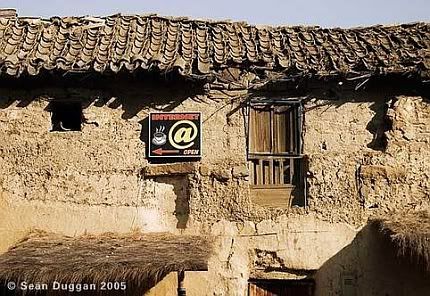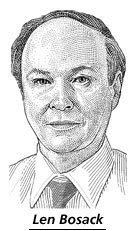 |
| October 2, 2007 Its Creators Call Internet Outdated, Offer Remedies By BOBBY WHITE. |
 |
| |
| In 1969, at the Pentagon's Advanced Research Projects Agency, Larry Roberts oversaw a program of connected research computers called ARPAnet that became the foundation for the Internet. Four decades later, he has spent nearly $340 million trying to redo that same technology, which he now believes is far behind the times. "We can no longer rely on last-generation technology, which has essentially remained unchanged for 40 years, to power Internet performance," says Mr. Roberts, who is 69 years old. Last month, his start-up, Anagran Inc., introduced a piece of gear called the flow router that he says can help modernize the Internet. The equipment analyzes Web traffic to discern whether it is an email, a movie or a phone call and then carves out the bandwidth needed for transmission. Mr. Roberts isn't the only networking pioneer dissatisfied with earlier achievements. Len Bosack, the 55-year-old co-founder and former chief technology officer of networking giant Cisco Systems Inc., helped commercialize routers, the core piece of networking equipment that allows computers to communicate with one another. Yet he now terms such gear "less and less adequate" for today's Internet needs. Last month, his company, XKL LLC, unveiled a system that allows businesses to connect to underground cables that have nearly 100 times the capacity of current telecommunications pipes. The actions of Messrs. Bosack and Roberts fuel the growing debate over whether the Internet's current infrastructure is sufficient to handle the explosion of bandwidth-hungry services such as Internet telephony and video. In a recent report, Cisco calculated that monthly Internet traffic in North America will increase 264% by 2011 to more than 7.8 million terabytes, or the equivalent of 40 trillion email messages. If such Internet traffic continues increasing, many believe networks could crash or at least slow to a crawl. "The increasing bandwidth demands on cable operators will soon reach crisis stage," wrote Stan Schatt, research director at ABI Research, in a recent report. Others disagree. Cisco, even with its forecast of great traffic growth, concludes Internet-service providers will be able to cope. Today, information travels the Web by being broken into tiny bits called packets, which are routed through the least congested pipes to their destination. Once the packets arrive, they are reassembled into their original form. The problem is that the increasing size of files, such as video, has begun overwhelming some equipment handling the traffic, resulting in errant or lost packets. To tackle the problem, a slew of start-ups are producing gear and software to accelerate Internet traffic or to increase the network's capacity. These include companies run by Messrs. Roberts and Bosack, as well as Riverbed Technology Inc. and Big Band Networks Inc. Other companies, such as BitGravity Inc. and Limelight Networks Inc., are creating "parallel networks" -- essentially scaled-down versions of the Internet -- to escape the glut of traffic on current networks. The target buyers for these start-up services are Internet-service providers and big companies with large networks of satellite offices. A business, for instance, can affect how quickly emails and other files flow to their branch offices depending on the equipment they use in their network. But many of the new start-ups aiming to cater to these needs aren't likely to survive. In the late 1990s, start-ups such as Celox Networks Inc., Chiaro Networks Inc. and Centerpoint Broadband Technologies Inc. also emerged to grapple with the growth in Internet traffic. All of those companies have since filed for bankruptcy or shut down, casualties of the telecom bust. Today's Web-traffic-control start-ups "really have their work cut out for them," says Michael Kennedy, a networking consultant with Network Strategy Partners LLC. "Technology doesn't always win the race." |
 |
| Mr. Roberts's concern over the Internet's infrastructure stretches back years. Even while at ARPAnet, he says he was unsure how long the technology could work, especially since the system didn't ensure that information packets would arrive at their destination. His fears crystallized in the late 1990s when he saw companies begin to use the Internet to make phone calls and consumers begin to dabble in online video. "The Internet wasn't designed for people to watch television," he says. "I know because I designed it." In 1998, Mr. Roberts, who worked at several networking start-ups in the 1970s and 1980s after leaving the Defense Department in 1971, founded a start-up called Caspian Networks Inc. He raised $317 million from venture capitalists for Caspian to manufacture the flow-based routers that could analyze Internet traffic and improve how that traffic moved. But the equipment -- priced at about $500,000 per router -- was too expensive for many customers. Mr. Roberts resigned in 2004 from Caspian; the company closed its doors last year. But the scientist's desire to improve the Web's infrastructure didn't abate. Two months after leaving Caspian, Mr. Roberts founded Anagran in Redwood City, Calif., and raised $22 million in venture funding to continue his work. This time around, he says, Anagran's product is cheaper -- costing just $70,000 -- and there is a more urgent need for such equipment. "Larry wants to get it right," says Dan Brown, a venture capitalist at ArrowPath Venture Partners in Redwood Shores, Calif., which has invested in Anagran. Anagran has already picked up customers such as Merit Networks Inc., of Ann Arbor, Mich., a nonprofit organization that builds networks for universities, and the International Center for Advanced Internet Research at Northwestern University. "Larry's equipment is built for the more complex traffic like Internet television," says Jim Chen, assistant director of networking at Northwestern. "It's a perfect fit for us." The XKL story began in Seattle in 1991, a year after Mr. Bosack and his former wife, Cisco co-founder Sandy Lersner, were ousted from Cisco. At the time, Cisco had just gone public and the company's venture capitalists figured the duo could no longer run the growing enterprise. Mr. Bosack soon sold most of his Cisco stock and concentrated on XKL. There, he focused on increasing the Internet's capacity through fiber optics, which are strands of glass capable of carrying 100 times more data than traditional wires. For more than a decade, Mr. Bosack worked in stealth mode on his technology. At the same time, he began noticing how businesses and consumers were finding unintended uses for the Internet, such as videoconferencing. "Some of this stuff was putting a heavy burden on the network," he says. That led to XKL's introduction of the DMX optical transport system last month. The $100,000 system allows businesses and service providers, rather than telecommunication companies, to manage and connect to fiber lines. XKL has only just begun to sign up customers, says Mr. Bosack. Messrs. Roberts and Bosack haven't met but know of each other through industry circles and say they have been following one another's progress. "We're pushing for the same thing," says Mr. Bosack. "The public needs something better than what's currently available." Write to Bobby White at bobby.white@wsj.com |
| Abrir/Comprar artículo en WSJ Américas. Privacy Policy Subscriber Agreement & Terms of Use Mobile Devices RSS Feeds Copyright © 2007 Dow Jones & Company, Inc. All Rights Reserved |
jueves, octubre 04, 2007
Los creadores de Internet dicen que ésta ya está obsoleta. Ofrecen soluciones.
Suscribirse a:
Comentarios de la entrada (Atom)
No hay comentarios.:
Publicar un comentario